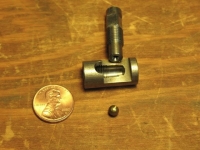The sliding universal table drive on the PMR 1/12 scale model milling machine...
calls for two 1/8" diameter brass balls, each drilled through with two orthogonal 1/16" holes. Drilling a single hole on diameter isn't that difficult (see my earlier post today for the technique) but keeping the two holes orthogonal, a necessity for this application, and on such a small part, required a somewhat more inventive jig.
A piece of 1/2" rod was drilled partially through. The conical bottom of the hole forms a pocket to orient the ball. A 1/16" guide hole is drilled into the larger hole from the other end to guide the drill into the center of the ball. A threaded rod with a conical tip threads into the large holder to trap the ball in the jig.
Here's what the assembly looks like with the ball in place.
With the ball in place, the location of the top of the ball (ie, the top opposite the end with the 1/16" hole) is measured relative to the 1/16" hole end. Knowing this dimension and the diameter of the ball, it's possible to calculate the location of the ball center relative to the jig end. A 1/16" hole is drilled into the ball at this point. Done carefully, it will be on the ball diameter.
Now the jig is stuck in a collet on the lathe and the 1/16" drill run through the guide hole, producing another hole orthogonal to the first.
Did it work? Yes, the sliding universal joint works very smoothly and doesn't bind.



 LinkBack URL
LinkBack URL About LinkBacks
About LinkBacks





 Reply With Quote
Reply With Quote


Bookmarks